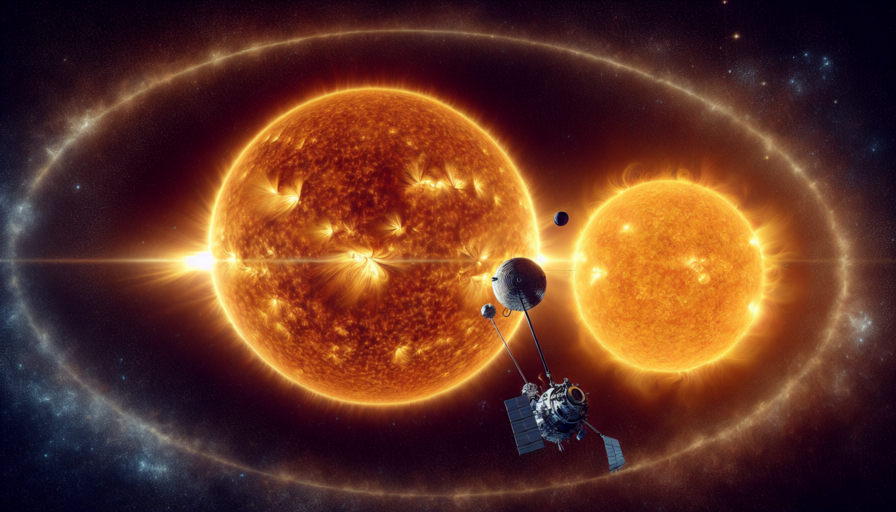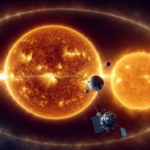Unlocking the Mysteries of Mercury with BepiColombo’s Sixth Gravity Assist
The exploration of Mercury has entered a thrilling phase with BepiColombo’s sixth gravity assist, a pivotal maneuver in its mission to unravel the enigmas surrounding the closest planet to the Sun. This intricate operation not only showcases human ingenuity in space exploration but marks a significant leap toward understanding Mercury’s unique environment and its formation. By utilizing the gravitational pull of Mercury itself, BepiColombo is ingeniously saving fuel while adjusting its trajectory for an eventual orbital insertion, setting the stage for unprecedented scientific discoveries.
The significance of this gravity assist cannot be overstated. Mercury, veiled in mystery, possesses a range of phenomena that defy our understanding of planetary science. Its magnetic field, exosphere, and the peculiarities of its orbit present puzzles that BepiColombo aims to solve. The mission’s successful execution of its sixth gravity assist is not just a testament to the precision and reliability of contemporary space navigation techniques but also brings us closer to answering longstanding questions about planetary formation and the dynamics of the inner solar system.
With each gravity assist, BepiColombo inches closer to its goal of entering Mercury’s orbit, where it will deploy its two orbiters: one focused on planetary observation and the other on investigating Mercury’s magnetosphere. This maneuver is crucial for diminishing the spacecraft’s speed relative to Mercury, ensuring that it can be captured by the planet’s weak gravitational field. The dual approach of the mission, combining close-range observation with detailed scientific measurements, promises to shed light on Mercury’s surface features, geological history, and potentially even clues about the origins of the solar system.
Exploring the Sun’s Enigmatic Neighbor: How BepiColombo’s Latest Maneuver Reveals Mercury’s Secrets
The enigmatic planet Mercury, shrouded in mystery and extreme conditions, has long intrigued scientists and astronomers. It’s a world of contrasts, with blistering daytime temperatures and frigid nights, lying close to the solar furnace we call the Sun. In an ambitious effort to peel back the layers of this mysterious world, the BepiColombo mission, a joint venture between the European Space Agency (ESA) and the Japan Aerospace Exploration Agency (JAXA), has embarked on a series of complex maneuvers designed to bring us closer to understanding Mercury’s secrets.
One of the most critical and recent maneuvers made by BepiColombo involves utilizing the planet’s gravitational pull to adjust its trajectory toward Mercury. This technique, known as a gravity assist, is not only a testament to human ingenuity in space navigation but also opens a new chapter in our quest to understand the solar system’s innermost planet. The maneuver allows BepiColombo to decelerate without expending fuel, using Mercury’s own gravity to draw it closer into a stable orbit, revealing the planet’s hidden details bit by bit.
In the wake of this maneuver, BepiColombo is expected to provide unprecedented insights into Mercury’s geological history, magnetic field, and exosphere composition. As the spacecraft edges closer, its suite of high-resolution imaging equipment and scientific instruments are poised to unlock answers to longstanding questions. Such as, why does such a small planet possess a magnetic field, unlike Mars or Venus? And, what can Mercury teach us about the formation and evolution of our solar system?
Moreover, this mission highlights the intricate balance required to explore our solar system’s extreme environments. The challenges of studying Mercury — from its proximity to the Sun to its rapid orbital speed — make each successful maneuver a monumental achievement. BepiColombo’s latest efforts not only underscore the complexity of space exploration but also mark significant progress in our journey to comprehend the cosmos. As the mission continues, each piece of data collected brings us a step closer to unraveling Mercury’s enigmatic nature.
The Pivotal Role of BepiColombo’s Sixth Gravity Assist in Understanding Mercury’s Mysteries
The BepiColombo mission, a collaborative project between the European Space Agency (ESA) and the Japan Aerospace Exploration Agency (JAXA), is ambitiously aimed at uncovering Mercury’s enigmatic characteristics. The sixth gravity assist maneuver, belonging to this interplanetary mission, emerges as a landmark event, pivotal in peeling the layers of mystery that enshroud Mercury. This flyby is meticulously designed to utilize the gravitational pull of Mercury itself, to adjust BepiColombo’s trajectory and speed without expending fuel, thereby setting the stage for subsequent, closer observations and analyses of the planet.
One of the intriguing aspects under scrutiny through the lens of the sixth gravity assist includes Mercury’s unique magnetosphere. Unlike other terrestrial planets in our solar system, Mercury possesses a magnetic field generated by its core. This specific maneuver provides a crucial opportunity to gather invaluable data regarding the dynamics of Mercury’s magnetosphere and how it interacts with solar wind, offering insights into the planet’s internal structure and its magnetic environment. Such information is vital for understanding both the genesis of Mercury and the evolutionary dynamics of terrestrial planets at large.
Moreover, the sixth flyby serves an instrumental role in refining our understanding of Mercury’s exosphere. By closely skirting the planet during this gravity assist, BepiColombo is expected to collect detailed observations of the exospheric composition and its variability. Exploring these elements allows scientists to deduce the processes contributing to the loss of atomic and molecular species from Mercury’s surface into space. This, in turn, enriches our comprehension of the chemical and physical processes shaping planetary surfaces and atmospheres in the harsh proximity of a star.
Additionally, the gravity assist’s role extends to enhance the precision of BepiColombo’s future operations. By achieving a closer approach and therefore a stronger gravitational interaction with Mercury, the maneuver not only aids in better trajectory adjustments but also facilitates a comprehensive mapping of the planet’s gravitational field. This critical information will fine-tune future approaches and landings, ensuring that subsequent observations and experiments conducted by BepiColombo are optimized for accuracy and depth of analysis, further contributing to our collective scientific knowledge about Mercury’s origins, environment, and potential for harboring conditions amenable to life.
Array










